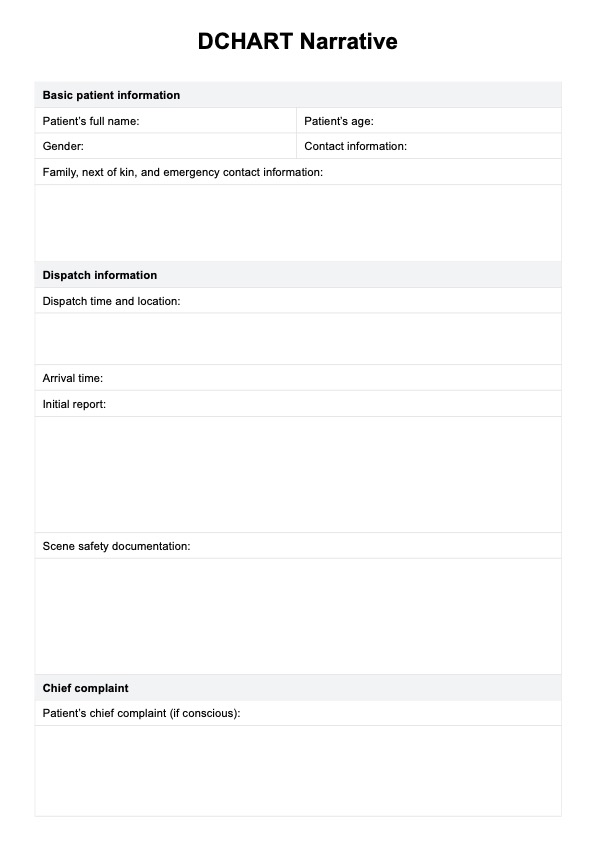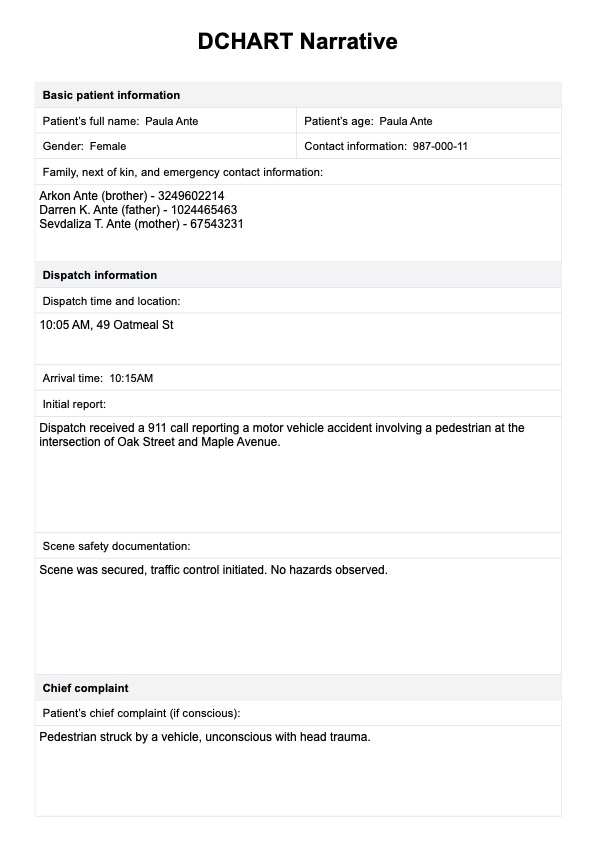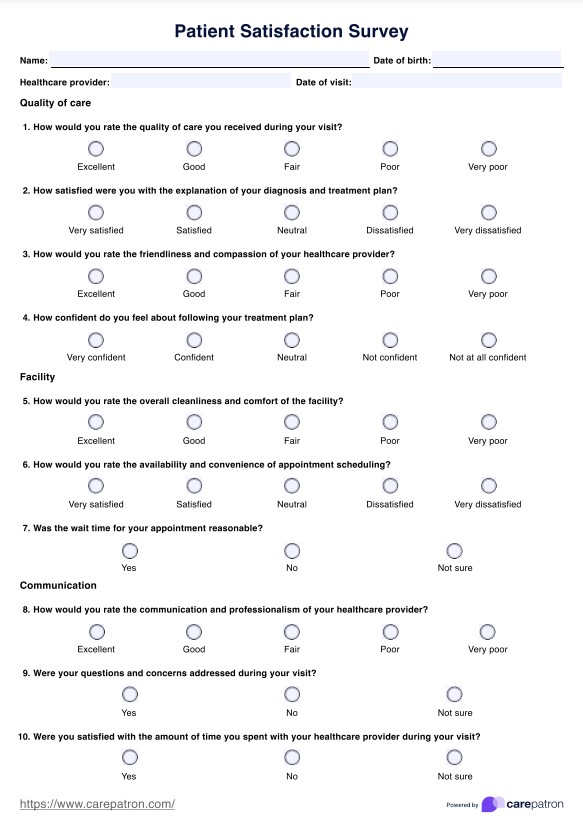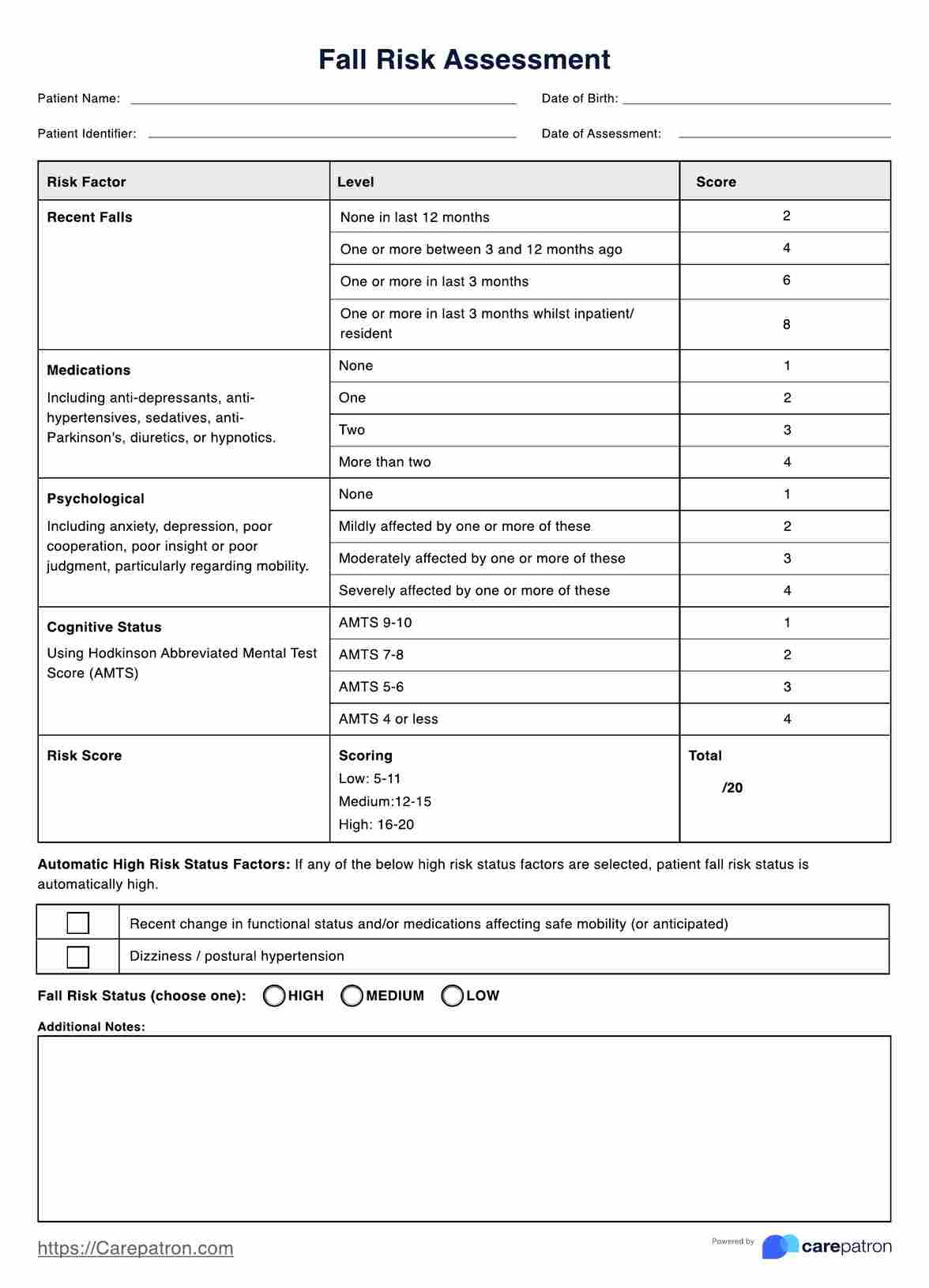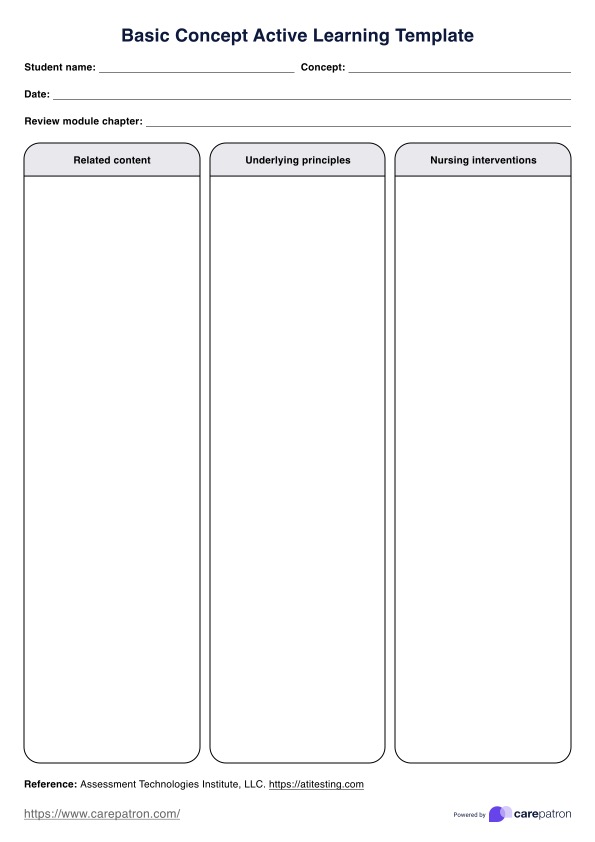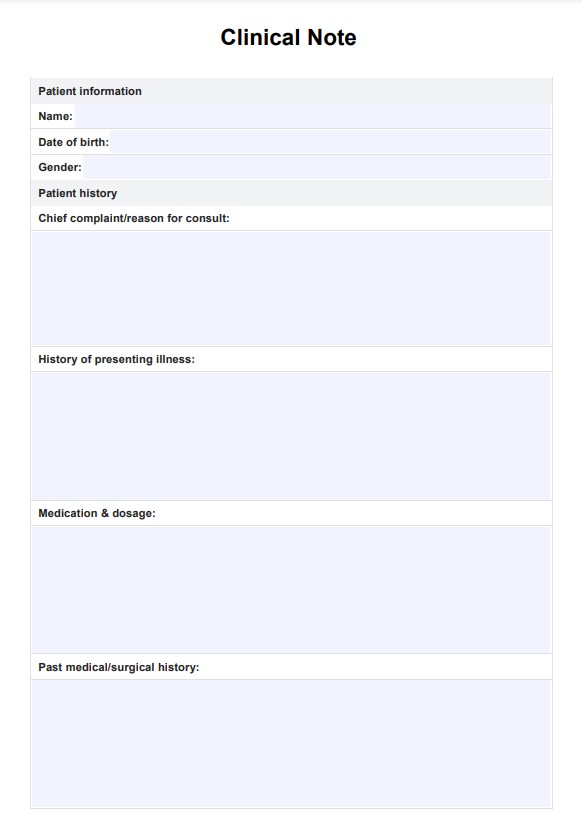DCHART Narrative
Get a free DCHART Narrative template and example in PDF format. Use this template to create effective EMS narratives.


What is a DCHART Narrative template?
Narrative recording in EMS documentation, typically under the DCHART framework, involves capturing a thorough and chronological account of the patient's condition, the interventions performed, and the patient's response to those interventions. This narrative should be clear, concise, and contain all pertinent information.
The DCHART Narrative systematically records patient information and medical events during emergency medical services (EMS) operations. It's an acronym for Dispatch, Chief Complaint, History, Assessment, Rx (Treatment), and Transport. This method ensures comprehensive documentation, which is crucial in emergency medical care for several reasons.
Firstly, the DCHART Narrative provides a clear and concise record that can significantly improve the clarity and efficiency of communication among healthcare professionals. This can enhance patient care by ensuring everyone involved understands the patient's condition and the treatment provided.
It also serves as a legal document. In legal disputes or investigations, the DCHART Narrative can provide crucial evidence about what happened during the call.
Finally, it can be a valuable patient care report tool for quality assurance and training. By reviewing a DCHART Narrative section, supervisors can identify areas of strength and areas that need improvement in their team's performance. Similarly, these narratives can be used in training scenarios to help new EMS personnel learn how to handle different situations effectively.
DCHART Narrative Template
DCHART Narrative Example
How does our DCHART Narrative template work?
Carepatron's free DCHART Narrative template is a digital and printable worksheet that can help you record information during an EMS operation. Here's how to use the template:
Step 1: Download the printable DCHART Narrative template
You can obtain a copy of the worksheet using the link on this page via the Carepatron app or our practice management software resources library.
Step 2: Print or use digitally
Use the DCHART Narrative template as a printable form to write patient information. Alternatively, you can also use the PDF version of the template on your computer or tablet with a digital pen.
Step 3: Gather essential details
Fill in the information required for each section of DCHART. Ensure all necessary details are gathered from the patient, bystanders, and other responders.
Step 4: Record findings and actions taken
In each section, describe the chief complaint, what you have observed (e.g., weak radial pulses, breath sounds are clear bilaterally, etc.), any interventions performed, and the patient's response to those interventions. Be sure to include any medications administered and their doses.
Step 5: Include relevant information from the pre-hospital care report
If you are using this template to supplement your pre-hospital care report, include any relevant information from the report in the designated section.
When would you use the DCHART Narrative template?
Our printable DCHART Narrative template is a simple yet comprehensive tool for emergency dispatch calls. It is especially useful when limited information about the patient's condition is available or additional details are needed to accurately record the call and response.
Some examples of situations where this template can be helpful include:
Major accidents or disasters with multiple patients
The template can help capture essential details about each patient, their injuries or conditions, and the appropriate response. This information can guide triage and treatment decisions and track patients' progress during transport.
Medical calls with a critical patient
When dealing with a critical patient, it is essential to relay accurate and detailed information to responding units. The DCHART Narrative template can prompt you to gather and document crucial information such as vital signs, if the patient is in pain, if they have specific conditions (e.g., skin conditions, bruises, etc.), medications administered, and interventions performed. This information ensures that responding units fully know the patient's condition and can prepare accordingly. Dispatch and arrival times should also be recorded.
Unknown or unfamiliar types of calls
Dispatchers may sometimes receive calls for incidents they have not encountered or require specialized knowledge. Our template can help you gather and document the necessary information for these calls, ensuring that all relevant details are captured accurately.
Documentation during high-stress situations
During critical incidents, you may experience higher stress or pressure. In such cases, it can be challenging to remember all the necessary information and record it accurately. Our template provides a structured format to help you remain organized and capture all the essential details despite high stress levels.
Tips for writing effective narratives in EMS
Writing narratives is an essential skill for EMS professionals. It allows you to communicate your observations, assessments, and interventions clearly and concisely to other healthcare providers.
Here are some tips to help you write effective narratives in EMS:
- Use a structured format: When writing a narrative, it is vital to have a structure in mind. This can help you organize your thoughts and ensure all relevant information is included.
- Start with the basics: Your narrative should always begin with basic information, such as the call's date, time, and location. This sets the scene for your readers and provides context for your observations.
- Include relevant details: Be specific in your descriptions and include relevant details such as vital signs, patient demographics, and any other pertinent information. This will help paint a clear picture for the reader and aid in their understanding of the patient's condition.
- Be objective: It is important to maintain objectivity when writing a narrative. Stick to the facts and avoid including personal opinions or biases. This ensures that your narrative remains unbiased and credible.
- Use medical terminology: When writing about assessments or interventions, it is important to use appropriate medical terminology. This helps you accurately communicate your observations and allows for clinical documentation consistency.
Commonly asked questions
EMS personnel use DCHART Narrative templates to document a patient's medical condition and provide necessary information for further treatment. These templates can be used for various purposes, such as patient handovers, hospital transfers, and incident reports.
Yes, with Carepatron's customizable templates, you can easily edit and customize the DCHART Narrative templates to meet your specific needs. You can also save your customized templates for future use.
This template can help you save time and ensure accurate documentation of a patient's medical condition. It also provides a standardized format for reporting, making it easier for healthcare professionals to understand and interpret the information.


